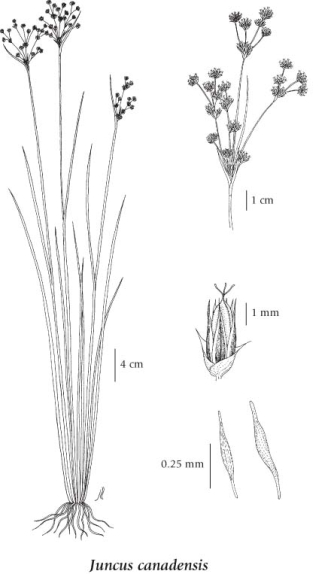Juncus canadensis J. Gay ex Laharpe
Canadian rush
Juncaceae (Rush family)
Introduction to Vascular Plants
Canadian rush
Juncaceae (Rush family)
Introduction to Vascular Plants
Species Information
General:
Perennial, tufted herb from short rhizomes; stems numerous, erect, 40-90 cm tall.
Leaves:
Located on the lower part of the stem, nearly circular in cross-section, tapered, stiff, with prominent complete cross-walls; sheaths open, with short, rounded, ear-shaped lobes.
Flowers:
Inflorescence terminal, conic, as wide as long to twice as long as wide, 5-20 cm long, the heads with more than 10 flowers, the branches spreading; perianth segments greenish-brown, 3.5-4.5 mm long, pointed, the inner shorter than the outer; stamens 6; anthers 0.7-1 mm long, shorter than the filaments.
Fruits:
Capsules, pointed, about as long as the perianth segments or only slightly longer; seeds spindle-shaped, about 0.4 mm long, with long, tail-like appendages on both ends that are more than 1/2 of the seed bodies.
Notes:
This species was erroneously treated as J. brevicaudatus in Ceska (1994).
Illustration

If more than one illustration is available for a species (e.g., separate illustrations were provided for two subspecies) then links to the separate images will be provided below. Note that individual subspecies or varietal illustrations are not always available.
Illustration Source: The Illustrated Flora of British Columbia
USDA Species Characteristics
Flower Colour:
Green
Blooming Period:
Mid Summer
Fruit/Seed characteristics:
Colour: Brown
Present from Summer to Fall
Source: The USDA
Habitat and Range
Wet meadows, peat bogs, lakeshores, and riverbanks in the lowland zone; rare in SW BC; introduced from eastern North America.Status Information
Synonyms
Synonyms and Alternate Names:
Juncus canadensis var. euroauster Fernald
Juncus canadensis var. sparsiflorus Fernald